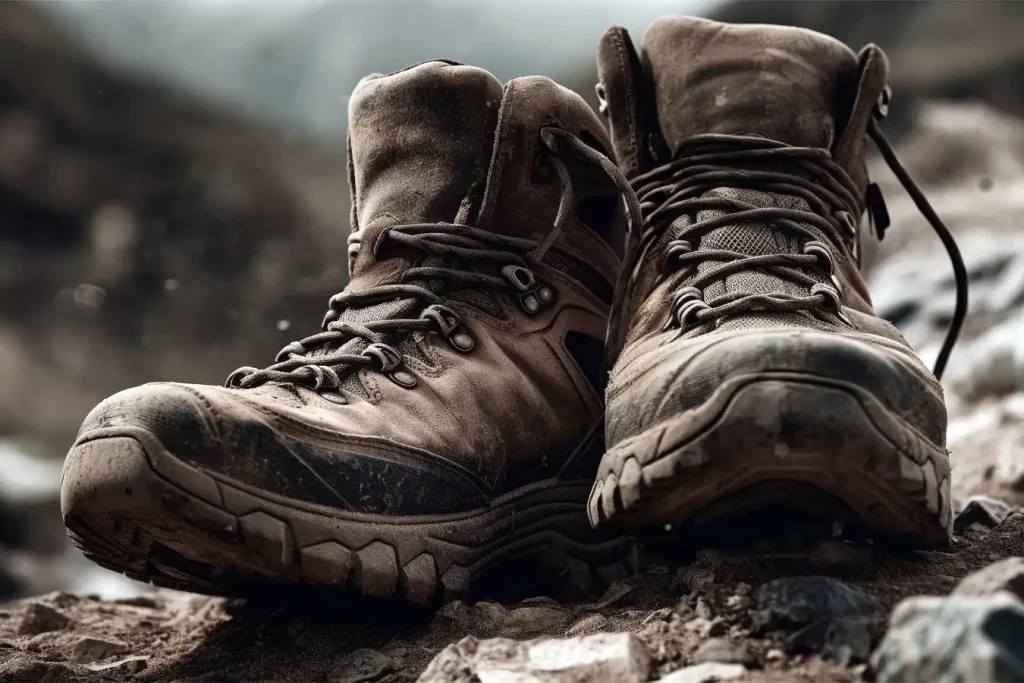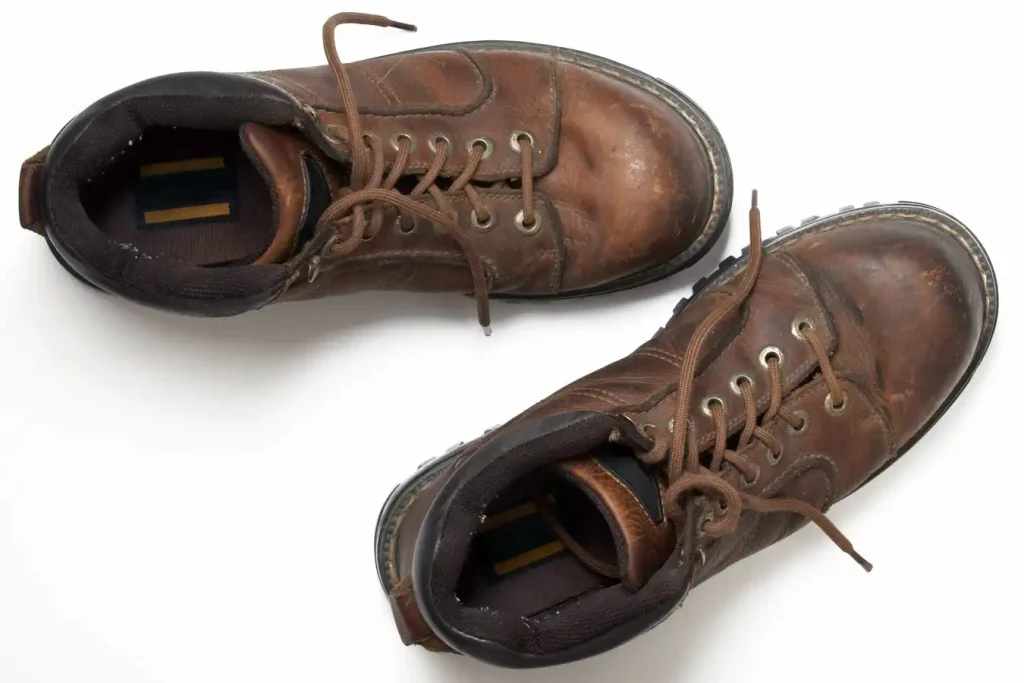“Hiking Boots vs Work Boots – what’s your pick?”
Hi, I’m Ovi Tanchangya, your outdoor companion, here to help you gear up right.
In this article, we’re diving into a footwear showdown that’s as old as the hills themselves.
We’re looking at hiking boots vs work boots, comparing their strengths and weaknesses to figure out which one truly stands up to the test.
Whether you’re a seasoned hiker or a hardworking professional, you’ll discover new insights and facts to consider next time you’re shopping for boots.
Stay with me as we embark on this exciting journey, and by the end, you’ll be able to confidently choose the right boots for your needs.
Understanding Footwear: A Primer
What’s in a boot, you ask? Quite a lot, as it turns out. To appreciate the distinctions between hiking and work boots, we must first delve into the anatomy of a boot, the history behind them, and what each type entails.
The Anatomy of a Boot
Boots are more than just leather and laces; they’re a work of functional art. They consist of several components, each playing a vital role in comfort, protection, and durability. The key parts include the upper, which covers the foot; the insole for comfort; the outsole that provides grip; and the midsole that offers cushioning and shock absorption. The materials, construction, and design can vary depending on the boot’s purpose – from conquering mountainous terrains to protecting workers in hazardous environments.
Brief History of Boots
Boots have been protecting our feet for centuries, with early examples dating back to 1000 BC. Over time, they evolved to meet the specific needs of various activities and professions. By the 20th century, specialized boots like hiking boots and work boots came into the picture, each boasting features optimized for their respective uses.
Hiking Boots: An Overview
Hiking boots are the trekker’s best friend. Designed for outdoor trails, they prioritize comfort, stability, and traction. These boots typically feature robust, waterproof materials to withstand harsh weather and rough terrains. The soles are designed for maximum grip, preventing slips and falls on uneven surfaces. They’re lightweight, to minimize fatigue, and provide ample ankle support for those long, strenuous hikes.
Work Boots: An Overview
On the other hand, work boots are all about protection and durability. Primarily designed for jobs in construction, manufacturing, and similar fields, these boots often feature safety enhancements like steel toes and puncture-resistant soles. They’re made to withstand heavy wear and tear and protect the wearer’s feet from falling objects, sharp materials, and electrical hazards. While they might not be as lightweight or flexible as hiking boots, they offer unmatched safety features crucial for hazardous workplaces.
The Specifics: Hiking Boots
Hiking boots are the ultimate travel companions for explorers at heart. Designed to weather the storm and navigate tricky terrains, these boots are an intriguing amalgamation of design ingenuity and material science. Let’s dive into the specifics.

Materials Used in Hiking Boots
Hiking boots employ an array of materials, each chosen for their unique attributes that contribute to the overall performance. The uppers are commonly made of leather (full-grain, split-grain, or nubuck) or synthetics like nylon and polyester for durability and water resistance. Inside, you’ll find breathable linings that wick moisture, keeping your feet dry and comfortable. The soles, typically made of hardy rubber, feature deep lugs for traction and a protective toe cap for added safety.
Types of Hiking Boots: Light Hiking Shoes, Hiking Boots, and Backpacking Boots
Hiking footwear is not a one-size-fits-all affair. It’s diversified to accommodate different hiking styles and terrain types.
- Light Hiking Shoes: These are essentially sturdy running shoes, perfect for day hiking. They’re lightweight, breathable, and provide ample comfort for less demanding trails.
- Hiking Boots: For trekkers venturing onto rougher terrains or hiking in challenging weather, these mid to high-cut models provide excellent ankle support and improved durability.
- Backpacking Boots: When you’re carrying a heavy backpack and tackling multi-day hikes, these high-cut boots with robust construction are your go-to. They’re designed for maximum support and durability, even on the roughest of trails.
The Benefits of Hiking Boots
Hiking boots are your key to unlocking adventures off the beaten path. Their main benefits lie in their purpose-driven design. The supportive structure prevents ankle sprains and provides stability on uneven ground. Waterproof materials keep your feet dry even in inclement weather, while the superior traction allows safe navigation across a variety of terrains. Not to mention, their durability ensures they’ll be your hiking companions for many excursions to come.
Limitations of Hiking Boots
Despite their many strengths, hiking boots do come with limitations. Their robust construction often makes them heavier than regular shoes, which could lead to quicker fatigue. They also require a break-in period, meaning they may not be super comfortable straight out of the box. Finally, while they excel in outdoor conditions, their bulk and aggressive tread design make them less suitable for casual or everyday wear.
Learn more: Mountaineering Boots Vs Hiking Boots
The Specifics: Work Boots
Just as hiking boots are to adventurers, work boots are to laborers. Crafted with the ultimate precision to offer comfort during long hours and protection against occupational hazards, work boots are a staple of the working world. Let’s delve into their defining features.

Materials Used in Work Boots
Work boots, designed for resilience and safety, utilize robust materials. The most common material for the upper is leather, prized for its durability, water resistance, and ability to mold to the wearer’s foot over time. Synthetic materials, such as nylon mesh, are often used for breathability.
Inside, you might find antimicrobial linings that combat odor. The soles, crafted from strong rubber or thermoplastic polyurethane (TPU), often feature slip-resistant treads and sometimes include puncture-resistant plates.
Types of Work Boots: Safety, Soft-Toe, and Slip-On Boots
Work boots come in various styles, each catered to specific work environments.
- Safety Boots: Also known as steel toe boots, these boots are designed to protect your feet from falling objects and compression hazards. They are a must-have for workers in construction, manufacturing, or any industry where heavy objects might pose a risk.
- Soft-Toe Boots: While they lack the reinforced toe, these boots offer the same high level of comfort and durability, and they’re perfect for jobs that don’t require toe protection.
- Slip-On Boots: These boots feature a design that allows the wearer to easily slip them on and off, ideal for jobs where you might need to change footwear frequently. Despite their convenience, they still provide necessary safety and comfort features.
The Benefits of Work Boots
Work boots might just be the unsung heroes of the labor force. They protect workers’ feet from injuries, offer support for long hours of standing or walking, and provide traction on slippery surfaces. Additionally, many models are waterproof and feature insulation, making them appropriate for use in various weather conditions.
Limitations of Work Boots
While work boots offer numerous advantages, they aren’t without their drawbacks. Similar to hiking boots, they can be heavy, and this can contribute to fatigue during long shifts. Also, the protective elements like steel toes can make the boots feel rigid and less comfortable, especially when new. And while they’re perfect for the work site, they’re not the most stylish option for social settings.
Hiking Boots vs Work Boots: A Comparative Analysis
Choosing between hiking boots and work boots can seem daunting. Both are designed for specific tasks, yet they share several overlapping features. This section aims to lift the fog on this common conundrum by scrutinizing their characteristics side by side.
Comfort: Hiking Boots vs Work Boots
Comfort is king when it comes to footwear. Both hiking and work boots make comfort a priority but in different ways.
Hiking boots prioritize flexibility and lightness to accommodate long treks, with a snug fit to prevent blisters. They also offer significant arch and ankle support, vital for uneven trails. Some might argue that they offer a more immediate ‘out of the box’ comfort due to the use of softer materials and their lighter build.
Work boots, on the other hand, focus on enduring comfort over long hours of standing or walking on hard surfaces. They are typically more substantial, offering excellent foot and ankle support. Although they may require a break-in period due to their tough materials, once this period is over, they can provide unmatched comfort for the daily grind.
Durability: Hiking Boots vs Work Boots
Both types of boots are built to last, but the durability requirement varies.
Hiking boots must withstand rocky trails, mud, water, and more, but their lighter materials mean they might wear out faster with regular use. Work boots, constructed with heavier materials like full-grain leather and sturdy rubber soles, are made to resist daily abuse from tools, heavy machinery, and tough surfaces, which often grants them a longer lifespan.
Safety Features: Hiking Boots vs Work Boots
When it comes to safety, work boots steal the limelight. Designed to shield your feet from a range of occupational hazards, they come equipped with safety toes, slip-resistant soles, and sometimes even puncture-resistant plates.
Hiking boots, while not featuring safety toes, provide excellent traction for rough terrains and stability for ankle support, important for preventing twists or sprains on uneven ground.
Weather and Terrain Adaptability: Hiking Boots vs Work Boots
Hiking boots are made for varying terrains and conditions — from dry desert trails to wet, muddy paths. Many offer waterproof options and insulation for cold-weather hiking.
Work boots also offer weather adaptability, with waterproof and insulated models. However, their terrain adaptability is more geared towards the flat, hard surfaces typically encountered in work settings.
Aesthetic and Style: Hiking Boots vs Work Boots
While style may take a back seat to function in this comparison, it’s worth noting. Hiking boots tend to sport a more adventurous, outdoorsy look, aligning with the activities they’re used for. Work boots offer a robust, no-nonsense aesthetic, suitable for a variety of casual settings, yet their sheer bulk may limit their social appeal.
So, which to choose? Hiking boots or work boots? It all depends on your needs. But remember, the right footwear can make all the difference in comfort, safety, and overall enjoyment whether at work or on the trail.
Learn more: Mountain Climbing Vs Rock Climbing
Practical Considerations
Choosing the right boot involves more than just a surface-level comparison of features. Let’s explore some practical considerations you need to ponder when deciding between hiking boots and work boots.
Deciding Factors: What to Consider When Choosing
When choosing between hiking boots and work boots, your decision should be largely influenced by your primary use for the boots.
If you plan on exploring nature trails, hiking boots with their lightweight design, excellent traction, and ankle support would be a smarter choice. They are designed to handle various terrains and provide comfort during long treks.
On the other hand, if you’re spending long hours on your feet at a construction site or a factory floor, work boots should be your go-to choice. Their sturdy build, safety features, and enduring comfort make them perfect for these environments.
Price Comparison: Hiking Boots vs Work Boots
Prices for both types of boots can vary significantly based on the brand, materials used, and specific features. Generally, quality hiking boots can range from around $100 to over $300. Work boots, given their robust construction and safety features, can fall into a similar price range or even go higher, particularly for high-end safety models.
Remember, a higher price doesn’t always equate to better quality or suitability for your needs. It’s essential to evaluate your requirements and budget before making a decision.
Maintenance and Care: Tips for Both
Regular care extends the lifespan of both hiking and work boots. Cleaning off dirt and mud after each use prevents material degradation. Waterproofing treatments help maintain the boots’ resistance to water, while conditioning keeps leather supple. Always dry boots thoroughly before storing them to avoid mold growth.
For work boots, additional care may be necessary due to exposure to harsher elements such as oil or cement. Using a stiff brush to remove hardened materials and applying a protective cream can help maintain the boots’ longevity.
Sustainability and Environmental Impact: What’s the Difference?
Sustainability and environmental impact are becoming increasingly important considerations. Generally, boots made from synthetic materials have a higher environmental footprint than those made from natural materials due to the energy-intense manufacturing process and non-biodegradability.
Some brands are pioneering the way with eco-friendly practices, offering boots made from recycled materials or using more sustainable production methods. If this factor is important to you, it’s worth researching the brand’s sustainability initiatives before purchasing.
Selecting the right boot involves an array of practical considerations, from usage and price to care and environmental impact. Being well-informed allows you to make a choice that matches your needs and values perfectly.
To know more: Snow Boots Vs Hiking Boots
Care and Maintenance of Boots
Regardless of whether you choose hiking boots or work boots, the longevity and performance of your footwear significantly depends on how well you take care of them. Let’s explore the key aspects of boot maintenance.
Cleaning Your Boots
After every use, give your boots a good cleaning. For boots caked in mud or dirt, use a stiff brush to clean off the debris. Remember, dried dirt can degrade materials over time, especially leather. For a more thorough cleaning, warm soapy water and a sponge can do the trick. Don’t forget to clean the inside of your boots too— remove the insoles and wash them separately.
Proper Storage
Proper storage of your boots can extend their life by preventing unnecessary damage. Always store your boots in a cool, dry place away from direct sunlight. Extreme temperatures or exposure to sunlight can degrade the materials. If your boots are wet, let them dry naturally before storing them away. Never dry them using a heat source as this can cause the materials to crack or warp.
Repair and Replacement
Inspect your boots regularly for any signs of wear and tear. Small issues like worn-down soles or damaged laces can be fixed easily and inexpensively if caught early. However, if your boots are showing significant signs of wear such as holes in the upper or separated soles, it might be time to consider a replacement.
FAQs about the difference between Hiking Boots and Work Boots
Can I use work boots as hiking boots?
What is the difference between work boots and hiking boots?
Are hiking boots good for everyday use?
Are hiking boots good for yard work?
Can I wear normal boots for hiking?
Are steel toe work boots good for hiking?
Summing it up
The world of boots can seem overwhelming at first with many factors to consider. But by understanding the key differences between hiking boots and work boots, you can make an informed choice based on your specific needs.
Whether you’re an avid hiker exploring nature’s wonder or a hard-working professional needing protection on the job site, it’s clear that the right boots can make all the difference.
But remember, no matter which boot you choose, proper care and maintenance are crucial to getting the most out of your footwear.
So, are you ready to step into the world of boots and make your choice? Whether it’s the adaptable hiking boot or the robust work boot, may your choice lead you to many comfortable steps ahead!
Also learn: Backpacking Vs Hiking


